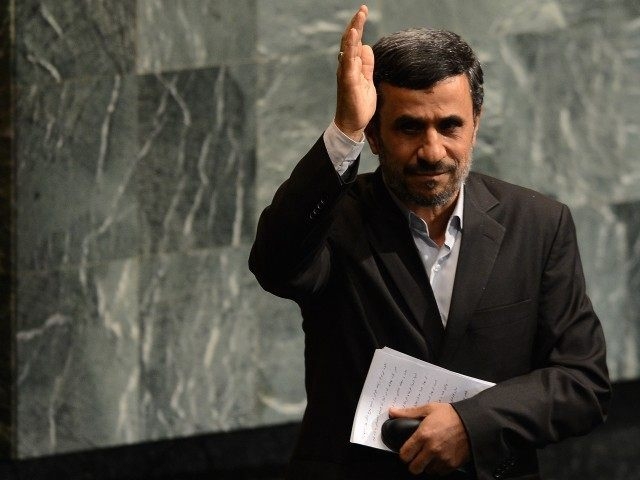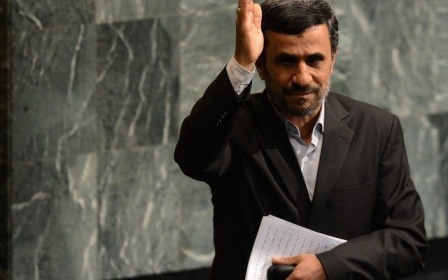Ahmadinejad banned Twitter in Iran. Now he's tweeting his comeback

When Iranians took to the streets in 2009 to protest against the government of then-president Mahmoud Ahmedinejad, their soon-stifled uprising was labelled the "Twitter revolution."
The social media giant was still in its infancy, but Iranian users had taken to the snappy mode of communication to organise themselves and express dissent.
Years before phone coverage was jammed in Tahrir Square or Gezi Park, the government seemed to sense Twitter's power, and it was soon banned, along with Facebook and, later, Instagram (most Iranians bypass these bans with VPNs).
But now Ahmedinejad himself seems to want in on the action, and has this week started tweeting, from @Ahmadinejad1956.
Never afraid of courting controversy, Ahmadinejad tweeted on Sunday that the late Venezuelan president, Hugo Chavez, is still alive and, in a video message, implored people to follow him.
The "Husband, Dad, Grandfather, University Professor, President, Mayor, Proud Iranian," as his bio describes him, originally joined Twitter in January.
Despite Supreme Leader Ayatollah Ali Khamenei warning him late last year not to stand in presidential elections this coming May, does this social media drive have some longer term political positioning in mind?
He needs to be engaged with his audience, and a Twitter account is a good idea
– Mahan Abedin
"Ahmadinejad wants to return to politics," Mahan Abedin, an Iranian political analyst, tells Middle East Eye, "but it is difficult for him to claim the centre stage again. Khamenei has effectively ruled him out for [standing in] presidential elections."
But, Abedin says, Ahmadinejad may be "looking further ahead, perhaps in four, five or even 10 years' time, when he might be able to stage a comeback".
And to do that, "he needs to be engaged with his audience, and a Twitter account is a good idea".
President in 2021?
Succeeded by current president Hassan Rouhani in 2013, when he reached his two-term limit, the former mayor of Tehran is eyeing a political comeback, agrees Shahir Shahidsaless, Iranian journalist and political analyst.
"I believe he is eyeing a run for office in 2021," he tells MEE.
Khamenei advised him not to run this year, Shahidsaless says, to "prevent the escalation of factional infightings that could lead to street fights".
But Ahmadinejad "is active… he just joined Twitter, he wrote a letter to Trump, he is travelling inside Iran and delivers speeches, and very recently has issued statements, attacking Rouhani and his administration".
Not only that, Shahidsaless says, but Ahmadinejad's close confidante Hamid Baqai has decided to run in this year's presidential elections.
Baqai has yet to receive official permission to stand from the Council of Guardians, and is "likely to be disqualified," Farideh Farhi, an Iranian scholar, tells MEE.
"But Baqai's candidacy offers Ahmadinejad an opportunity to be in the public eye and present himself as still a political force."
Abedin believes that Ahmadinejad would like to stand for president again one day, if he could, but that right now the "establishment is mobilised against him, and not least because he is a very strong candidate who could beat anyone."
"My view is the establishment wants Rouhani to secure a second term," he adds.
Despite his often fiery rhetoric and human rights abuses, Ahmadinejad remains popular, Abedin says.
"He has a lot of public support. He is charismatic, ballsy and very smart."
For Mohamad Bazzi, journalism professor at NYU, it is exactly this public adulation that Ahmadinejad misses, and which has pushed him to join Twitter.
"I suspect that Ahmadinejad misses the public spotlight - he wants to be part of the public debate in Iran and in the international spotlight once again," Bazzi tells MEE, while not ruling out that he could be positioning himself to run for president this year, despite Khamanei's warning.
This is part of his rather desperate effort to remain relevant
– Farideh Farhi
Throughout his time as president, which spanned from 2005 to 2013, "Ahmadinejad worked hard to cultivate his image as a pan-Islamic populist leader who was not afraid to stand up to the West," says Bazzi, who is writing a book about the proxy wars between Saudi Arabia and Iran.
"He quickly became more popular with Arabs than among his own people, who were frustrated by his inability to improve a stagnant economy, root out corruption, and redistribute oil wealth."
This image was, Bazzi says, "reinforced by his tendency to wear sport jackets and eschew many trappings of power".
But ultimately, he adds, Ahmadinejad became "just another despot in the region".
Farhi believes Ahmadinejad's sudden embrace of Twitter "is part of his rather desperate effort to remain relevant".
"So his sudden public appearance on Twitter, writing in English no less, like his recent public letter defending his record and letter to Trump, is part of an effort to get attention wherever he can get it, domestically or abroad."
Abedin agrees that regardless of any political aspirations, the former president likely misses the spotlight.
"If you remember his annual appearances at the UN, he loved the limelight and very unusually for a politician and putative statesman he appeared unscripted in front of potentially hostile audiences. He is the real deal."
Whether or not that rhetoric can be condensed into 140 characters at a time is yet to be seen.
New MEE newsletter: Jerusalem Dispatch
Sign up to get the latest insights and analysis on Israel-Palestine, alongside Turkey Unpacked and other MEE newsletters
Middle East Eye delivers independent and unrivalled coverage and analysis of the Middle East, North Africa and beyond. To learn more about republishing this content and the associated fees, please fill out this form. More about MEE can be found here.




